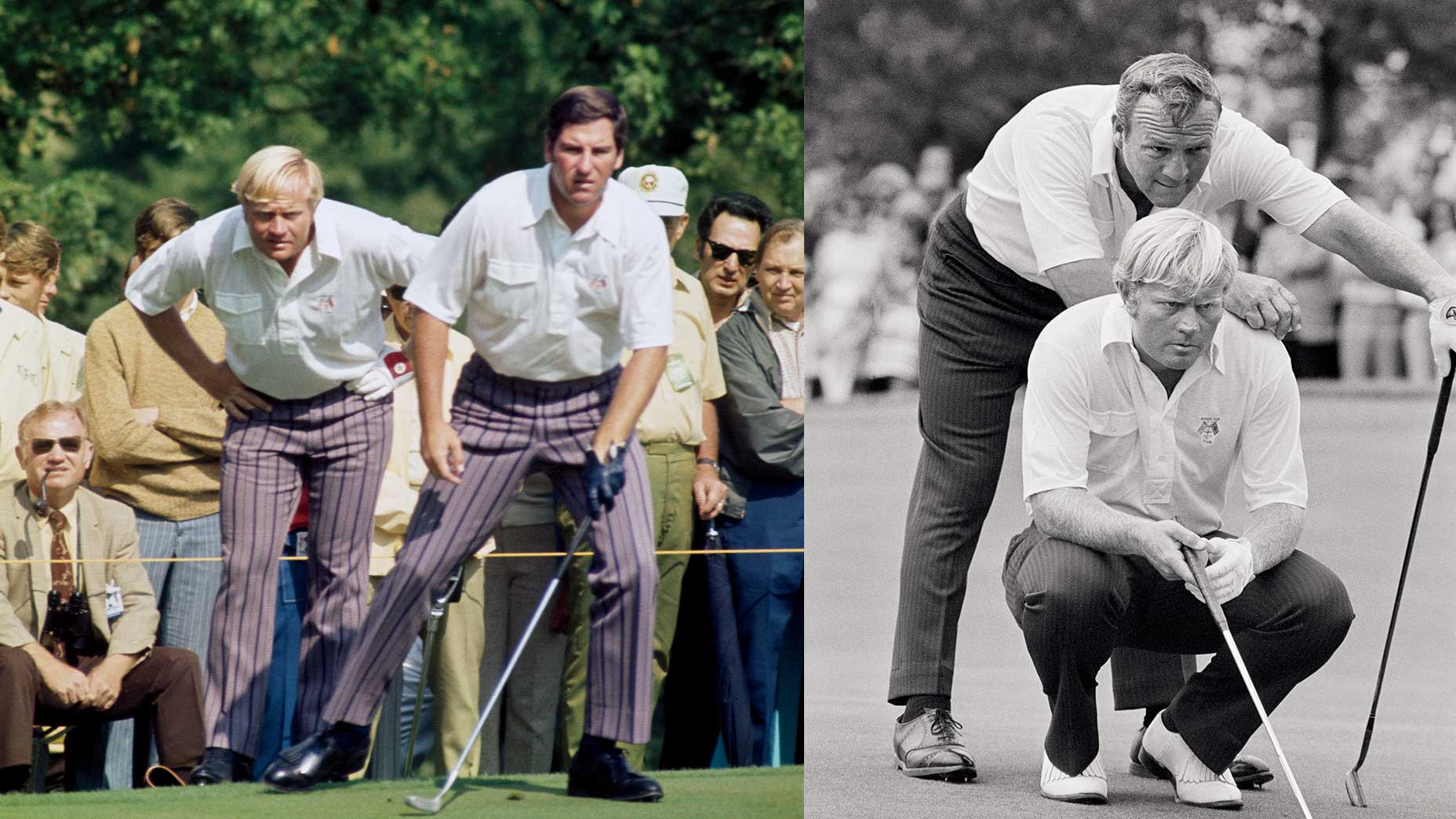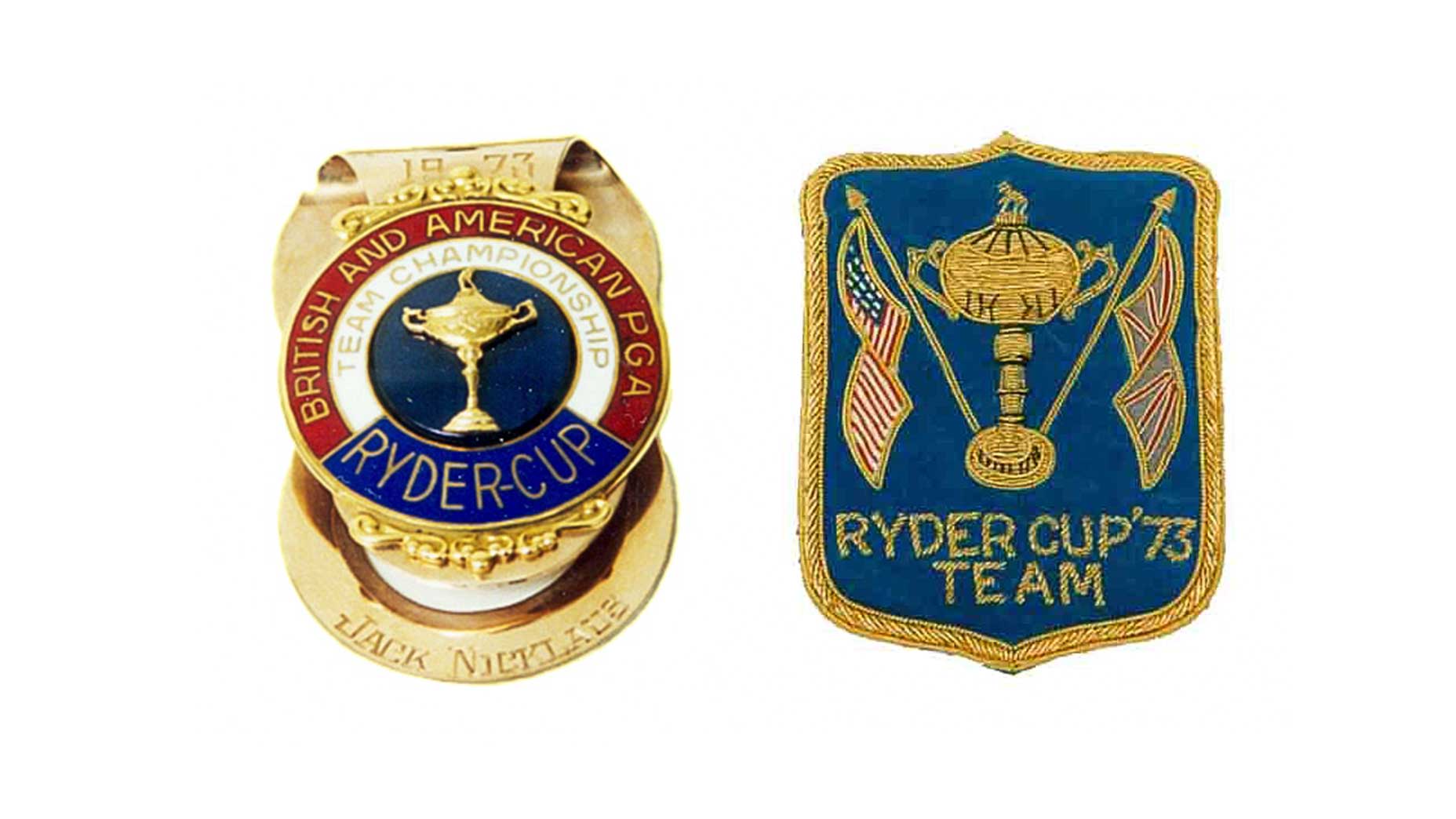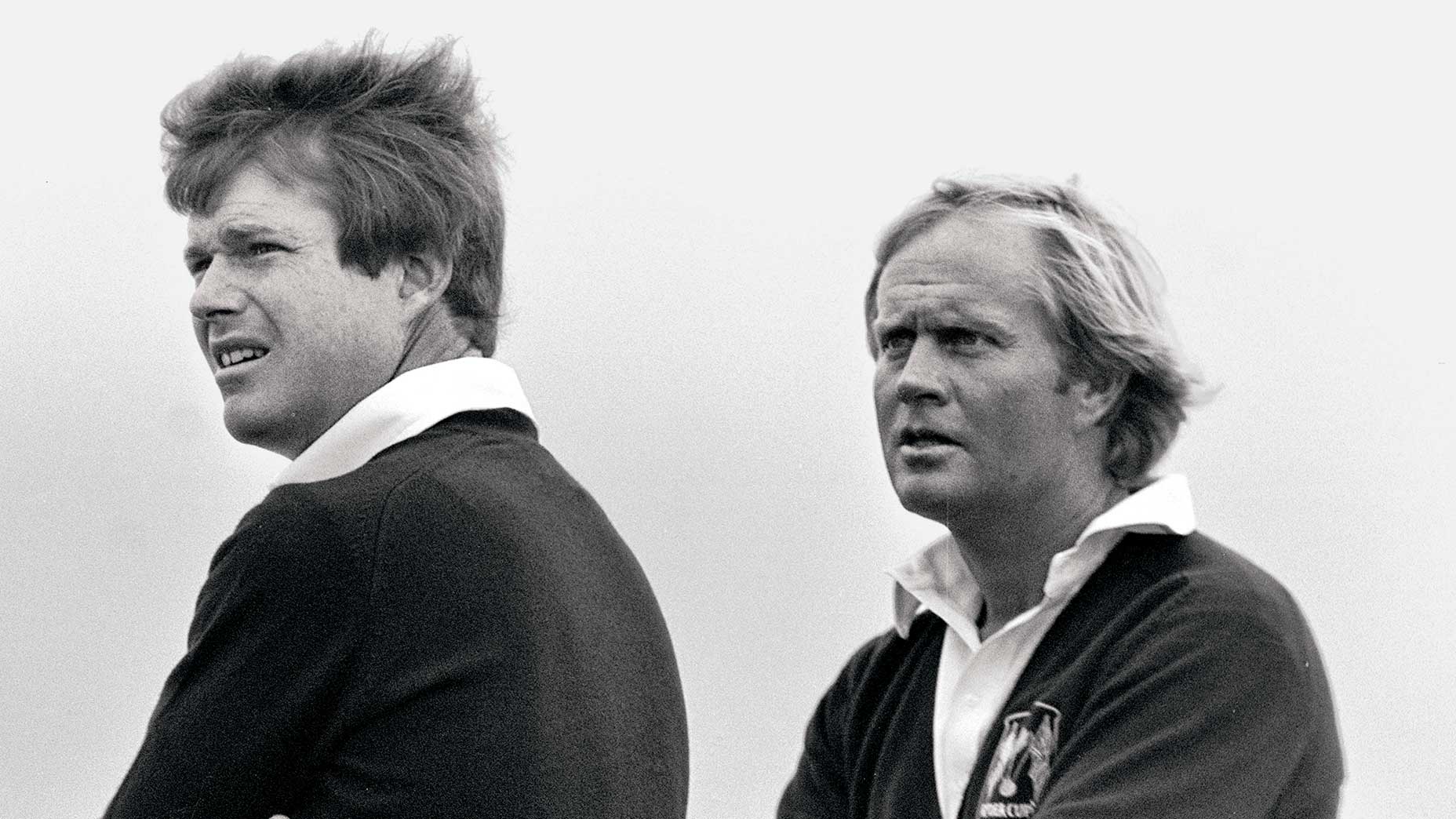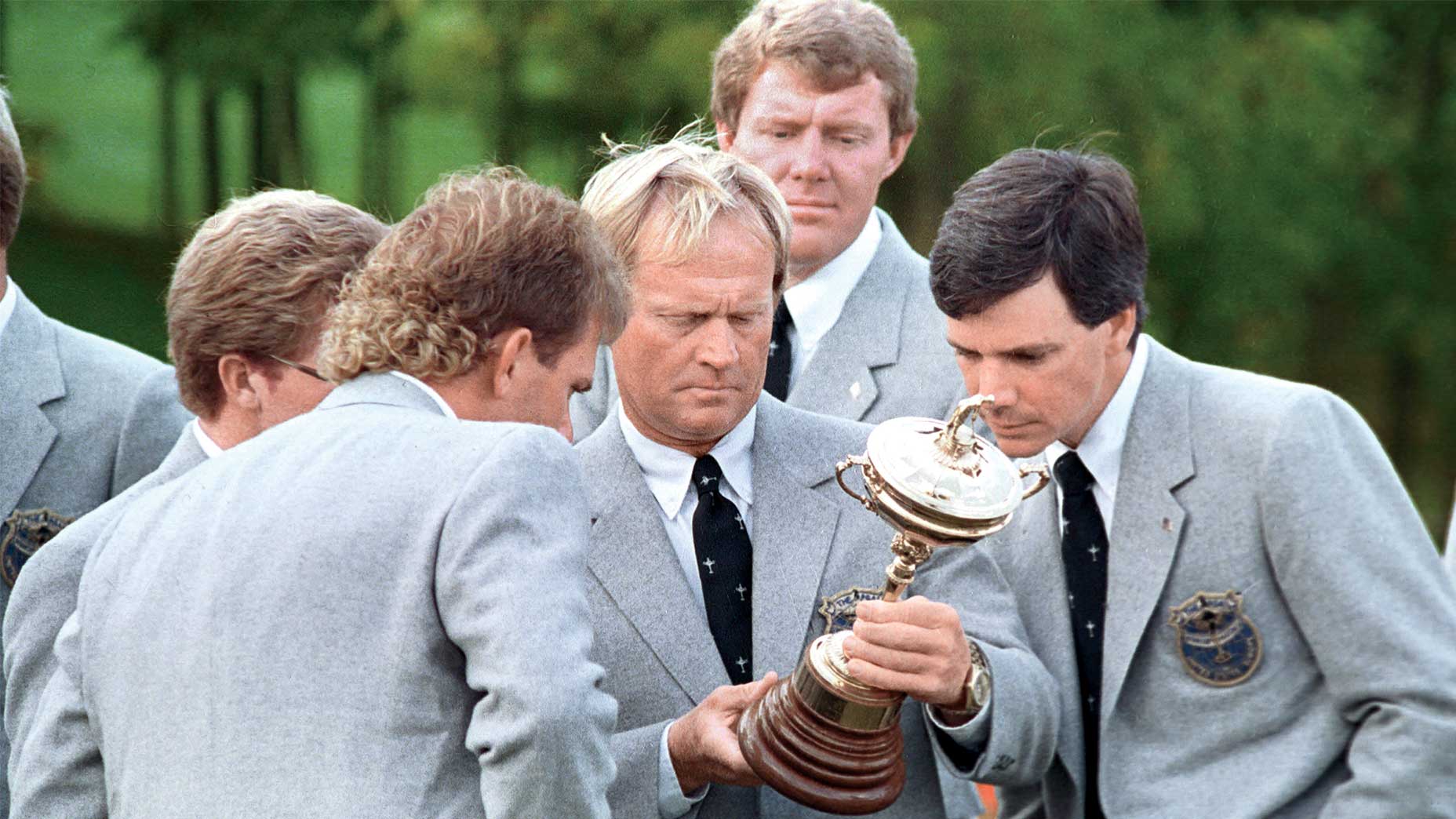
One of the greatest moments in Cup history: Jack concedes Tony Jacklin’s putt in ’69.
PA Images via Getty Images
Remarkably, the 1969 Ryder Cup matches at Birkdale were the first for Jack Nicklaus (by then a seven-time major winner) due to a PGA of America rule that mandated a five-year “apprenticeship” before Ryder Cup points could be earned. After a seven-year wait, U.S. captain Sam Snead initially decided not to play the Golden Bear in the first day’s foursomes (“I’m going to hold my big boys in reserve,” said Snead) — but called on Nicklaus and Dan Sikes for an afternoon point when the U.S. trailed by three after the a.m. matches.
In the format of the time, Nicklaus faced Tony Jacklin twice in final-day singles. Jacklin won 4 and 3 in the morning, and Nicklaus conceded what would have been a nerve-racking three-footer to halve their afternoon match—and the ’69 matches overall. “The Concession” immediately became the stuff of legend and the gold standard for Cup sportsmanship and beyond.
Below, check out the finest moments from Nicklaus’ illustrious Ryder Cup career, in his words and those of his teammates and competitors.
1969
U.S. 16; GB 16
Royal Birkdale GC — Southport, England
“I thought about what Tony Jacklin meant to British golf as the new Open champion, and how if he missed this putt he would be criticized forever. This went through my mind quickly, and I decided I wouldn’t give him the opportunity to miss. I picked up his marker, we shook hands and walked off.” —Jack Nicklaus
1971
U.S. 18 1/2; GB 13 1/2
Old Warson CC — St. Louis, Missouri
In his second Ryder Cup, Nicklaus went 5–1 in six matches, and Arnold Palmer went 4–1–1 in his five to lead the U.S. to an easy win. Working the bag for Nicklaus was a high school freshman named Mike Smith, who, like all the other caddies that week, was from a local club and received his assignment based on names drawn from a hat. On the second day’s afternoon four-ball, Jack and Arnie were partnered for the first time in the Ryder Cup, and they took down Peter Townsend (not The Who guitarist) and Harry Bannerman 1-up when Nicklaus canned a 15-footer at 18 in gathering darkness. The match was a test for the two American legends — Bannerman and Townsend birdied six of the first seven holes.
“During a practice round at the 1971 Ryder Cup, Nicklaus hit a 3-wood for his second shot into a bunker over the green at Old Warson’s 620-yard par-5 16th hole. He dropped another ball and fired a 1-iron hole high to 10 feet. Doing some quick post-round math for a reporter, Jack clocked the first drive at 360 yards.” —Mike Smith, Nicklaus’ caddie at the ’71 Ryder Cup.

While Nicklaus and Dave Stockton—and their pants—lost their match in ’71 (left), Jack and Arnie notched a win in their first-ever Ryder Cup pairing (right).
Getty Images/Bettmann Archive
1973
U.S. 19; GBI 13
Muirfield — Muirfield, Scotland
For the second Ryder Cup in a row, Nicklaus was the leading point winner on a victorious U.S. squad, reeling in 4½ over the three days. The format was altered in ’73 so that each of the first two days had foursomes and four-ball matches, rather than foursomes the first day and four-ball the second. Nicklaus was paired twice with Palmer on the first day. They won handily (6 and 5) in the morning alternate shot but lost to Maurice Bembridge and the indomitable Welshman Brian Huggett in Better-ball. That match marked the end of Nicklaus/Palmer in Ryder Cups—’73 was Palmer’s final year on the U.S. team as a player. “We just got our ears pinned back,” said Nicklaus after the match. “Jack [Burke, U.S. captain] wanted to get two sure points by pairing Arnold and me in both matches, but it just didn’t quite work out that way. Neither of us could make any birdies in the afternoon match.” The next day, Burke paired Nicklaus with Tom Weiskopf in both formats. The new team won two points, helping the U.S. pull level by day’s end. —Quotes from The Atlanta Constitution, September 21, 1973; Associated Press

To the winners go, well, the trinkets.
Jack Nicklaus Museum
1975
U.S. 21; GBI 11
Laurel Valley — Ligonier, Pennsylvania
In a blowout that begat serious questions of the future viability of the Cup, Nicklaus lost two singles matches to Brian Barnes. “This morning I felt so sorry for him,” said Barbara Nicklaus. “But this afternoon I was mad at him. He wouldn’t listen to me when I told him at lunch what he was doing wrong.” — John Husar, Chicago Tribune Press Service, September 22, 1975
1977
U.S. 12 1/2; GBI 7 1/2
Royal Lytham and St. Annes GC — Lytham St. Annes, England
After the U.S. romp in ’75, Palmer had suggested that perhaps the Britain and Ireland team might expand to include any nation in the British Commonwealth, thus making the matches more competitive. The idea didn’t gain much traction, but the idea didn’t go away either. During the 1977 Ryder Cup, Nicklaus engineered a meeting between the presidents of the U.S. and British PGAs. “I don’t know I played that much of a role,” Nicklaus told the Tour years later. “I took [PGA of America’s] Henry Poe to meet [British PGA’s] Lord Derby and said to Lord Derby, ‘We have a great match, but we are now The European Tour and should include Europe.’ It created an event that grew tremendously, and I am proud to be a small part of that.” Whatever Nicklaus’ role, that meeting helped changed the Ryder Cup forever.

A few months after their “Duel in the Sun” at Turnberry, Nicklaus and Tom Watson teamed up at Lytham to spank Tommy Horton and Mark James 5 and 4 in alternate shot.
Bob Thomas Sports Photography via Getty Images
1981
U.S. 18 1/2; Europe 9 1/2
Walton Heath GC — Walton-on-the-Hill, Surrey, England
After going 17–8–3 as a player, Captain Jack (and fam) guided the ’83 squad to a tense one-point victory over Europe, secured by a Lanny Wadkins birdie at the final hole of the final match. Nicklaus had pressed for a better contest, and the Europeans, led by Jacklin as their captain and Seve Ballesteros as their soul, made it one.

The patriotic footwear from Jack’s final Ryder Cup as a player.
Jack Nicklaus Museum
1983
U.S. 14 1/2; Europe 13 1/2
PGA National GC — Palm Beach Gardens, Florida
In his swan song as a Cup player, Nicklaus won all four of his matches after failing to qualify for the team in 1979. Watson and Nicklaus were paired together three times by U.S. captain Dave Marr and delivered three wins. On the final day, in his final match as a player, the Bear defeated Eamonn Darcy 5 and 3. The U.S. side was possibly its most talented ever—11 of the 12 players either were or eventually became major champs. Golf history is filled with foreboding, and one hero of the day in 1987, when Europe won for the first time on U.S. soil, was Darcy himself, who knocked off Ben Crenshaw in the last hole of their singles match (which saw Crenshaw putt for the last 12 holes with an iron after breaking his putter in frustration). Nicklaus was captain of that U.S. team.
1987
Europe 15; U.S. 13
Muirfield Village G.C. — Dublin, Ohio

Nicklaus and team eye the cup the Euros won.
The Associated Press
“Our guys played their hearts out,” he said, “but it was more than they could handle. They weren’t quite as tough as the Europeans down the stretch.” —Reid Hanley, Chicago Tribune, September 28, 1987









